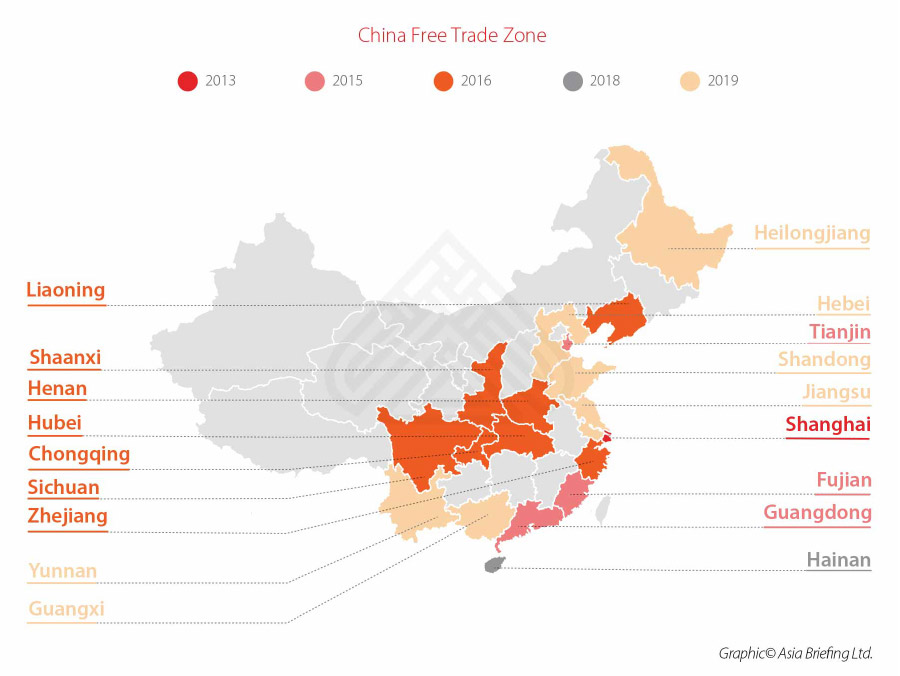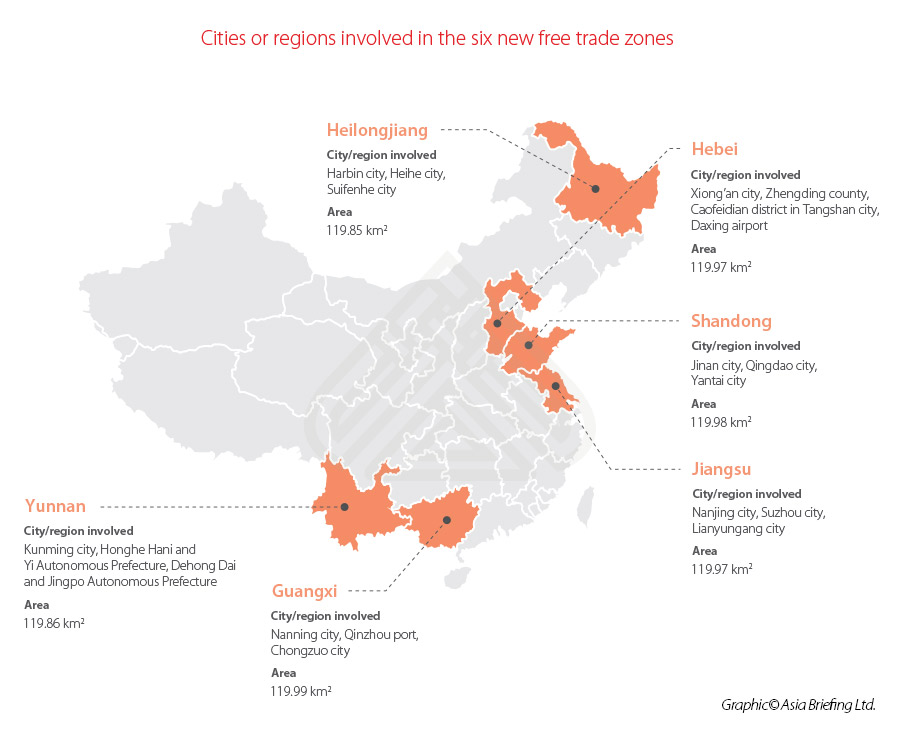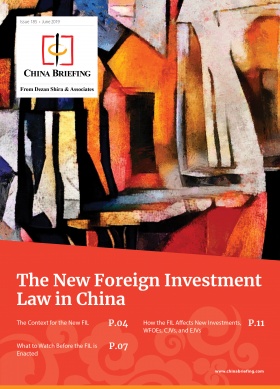China’s Six New Free Trade Zones: Where Are They Located? (2019 Expansion)
On August 26, China announced it will be expanding pilot free trade zones (FTZ) to six new provinces across the country. These are Jiangsu, Shandong, Hebei, Heilongjiang, Guanxi, and Yunnan.
The move, which will raise the total number of China’s FTZs from 12 to 18 – aligns with the government’s ongoing reforms to open up the economy.
The expansion plans aim to deepen China’s trade and economic ties with neighboring countries while also bolstering the local economy in underdeveloped provinces.
FTZs to ease regional trade and investment
The new FTZs are all located along the coastal or border regions and will serve as major gateways for trade and investment flows with Russia, Japan, South Korea, and Vietnam.
The FTZ expansion comes just weeks after another escalation in the US-China trade war.
In mid-August, both China and the US announced substantial tariff hikes – the US announcing tariffs on US$300 billion worth of goods to be implemented in two tranches and China reciprocating with additional tariffs on US$75 billion worth of goods.
It appears that China is looking to strengthen its underdeveloped provincial economies and secure stronger regional links, such as through the Belt and Road Initiative (BRI), to offset the impact of current trade tensions.
“The [new pilot FTZs] will not only help to optimize the strategic distribution of pilot FTZs, but also serve major national strategies such as the Belt and Road Initiative,” Chinese Vice-Minister of Commerce Wang Shouwen explained at the Press Conference announcing the new FTZs.
Alongside this, Shanghai’s Pilot FTZ recently extended its boundaries to the Lingang area – almost doubling in size and launched a slew of tax incentives and policy support for businesses in this area.
Together the new FTZs signal China’s decision to become more proactive in combating the slowdown caused by the trade war, through the acceleration of opening up reforms and fostering relationships with alternative trade partners.
FTZs play an important role in modernizing China’s business landscape, serve to stimulate domestic and foreign trade, and attract foreign direct investment. They offer preferential policies for the import, handling, manufacturing, and exporting of goods, as well as through tax incentives, free flow and exchange of capital, and fast-tracked procedures for investment.
Making use of geographical advantages
The Ministry of Commerce and the Ministry of Resource will be responsible for marking out the new pilot free trade zones, before submitting then to the State Council for filing.
This year will see the addition of FTZs in:
- Yunnan, the landlocked province that borders Vietnam, Laos, and Myanmar;
- Guangxi, the southern autonomous region that borders Vietnam;
- Heilongjiang, the northeastern province that borders Russia; and
- Shandong, Jiangsu and Hebei, the coastal provinces that sit across the ocean from South Korea and Japan.
“The Overall Plan for Six New Free Trade Zones”(Guofa [2019] No.16), in conjunction with the “Reply on the Approval of the Establishment of Six Free Trade Zones” (National Letter [2019] No. 72), provide details on the scope, layout, and measures of each FTZ, emphasizing each province’ strengths and needs when introducing the new reforms.
Specifically, “the FTZ will tap into respective geographical advantages to deepen trade and economic cooperation with neighboring countries and regions,” said Chinese Vice-Minister of Commerce Wang Shouwen.
Many of the FTZ plans share a common theme of heightening trade facilitation, improving investment promotion and protection, optimizing trade structure, and easing the business environment.
However, “[the plans] include distinctive and differentiated pilot reforms tasks in keeping with the strategic positioning and local features of the pilot FTZs,” the Chinese Vice-Minister of Commerce Wang Shouwen explains.
Shandong Pilot FTZ
Shandong Pilot FTZ covers three areas, including parts of Jinan, Qingdao, and Yantai, amounting to 119.98 square kilometers.
This FTZ will focus on accelerating the development of marine industries, development of industrial finance, artificial intelligence as well as the medical and health care industry as well as capitalizing on its strategic location to increase international trade cooperation between China, Japan, and South Korea.
Jiangsu Pilot FTZ
The Jiangsu Pilot FTZ covers three areas in Nanjing, Suzhou, and Lianyungang, adding up to 119.97 square kilometers.
One of the primary goals of this zone is to facilitate the cooperation with provinces and cities in the Yangtze River Economic Belt and the Yangtze River Delta to promote regional integrated development.
The pilot FTZ will include specific measures to improve the level of overseas investment cooperation, strengthen financial support for the real economy, and support innovation and development of the manufacturing industry.
Heilongjiang Pilot FTZ
The Heilongjiang Pilot FTZ covers parts of Harbin, Heihe, and Suifenhe, coming to 119.85 square kilometers and will be a key driver of revitalization of northeast China.
According to Beijing, this zone will support emerging industries, such as high-end equipment, smart manufacturing and new energy, as well as offering incentives for commercialization of technological achievements.
It also will help boost the economies along China’s rust belt – enhancing cooperation between China and Russia as well as the East Asian region.
Hebei Pilot FTZ
The Hebei Pilot Free Trade Zone covers areas in Xiong’an, Zhengding, Caofeidian, and the Daxing Airport, which comes to 119.97 square kilometers altogether.
This FTZ will promote the coordinated development of Beijing, Tianjin and Hebei (otherwise known as the Jing-Jin-Ji region). It will do so by spearheading the high-quality development of Xiongan New Area through financial innovation, digital technologies and platforms, and accelerating the technological achievements in bio-medicine and health sectors Beijing and Tianjin.
Yunnan Pilot FTZ
The Yunnan Pilot FTZ covers parts of Kunming, Honghe, and Dehong, which is 119.8 square kilometers.
Yunnan’s FTZ is located at an important economic corridor interconnecting the BRI and the Yangtze River Economic Belt.
The FTZ will thus act as an opening-up frontier linking China, South Asian, and Southeast Asian countries and build a world-class healthy lifestyle destination by introducing high-end medical resources from home and abroad.
Guangxi Pilot FTZ
The Guangxi Pilot FTZ covers three areas in Nanning, Qinzhou, Chongzuo area, adding to about 119.99 square kilometers.
The FTZs aim to function as an international land and sea trade corridor connecting China with other ASEAN countries, such as Vietnam, Laos, Thailand, and the Philippines.
As an important gateway linking the land and sea routes of the BRI (also known as the 21st Century Maritime Silk Road and the Silk Road Economic Belt), these zones will be key gateways for tourism, cross-border finance, and logistics.
Role of FTZs within China’s reform plans
The announcement of the six new pilot FTZs come at a crucial time.
Already US tariffs on Chinese goods have caused many tech factories to relocate to Southeast Asia and have forced China to look for more reliable alternate trade partners, such as Russia for energy and agricultural goods.
The new pilot zones will open new channels of trade and investment with China’s larger neighborhood, hopefully taking away some of the heat from its deteriorating relations with the US.
In any case, the desired effect will be twofold. Attracting more foreign business to China and supporting the development of domestic economic clusters like the Jing-Jin-Ji, Yangtze River Economic Belt, and the Northeast region.
Still, many remain skeptical of the role of FTZs in China – as the proportion of foreign investment drops despite added incentives. According to media sources, Dalian, one of the three pilot FTZs situated in Liaoning province, experienced a significant 17.6 percent drop in foreign direct investment in 2018.
Similarly, Shanghai’s FTZ has seen a decline in each of the most recent last three years, falling 3.5 percent to US$6.77 billion in 2018.
Nevertheless, put altogether – FTZs in key locations, the latest changes to the FI National Negative List, and the new Foreign Investment Law – demonstrate China’s commitment to building a more open economy following international best practices.
About Us
China Briefing is produced by Dezan Shira & Associates. The firm assists foreign investors throughout Asia from offices across the world, including in Dalian, Beijing, Shanghai, Guangzhou, Shenzhen, and Hong Kong. Readers may write to china@dezshira.com for more support on doing business in China.
- Previous Article Disparities in China’s Regional Growth: A Look at H1 2019 GDP Data
- Next Article ASEAN-China FTA Amendments to Ease Market Access










